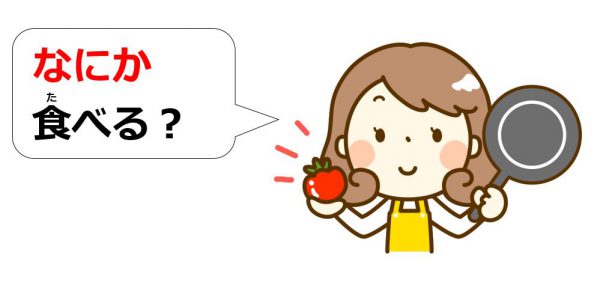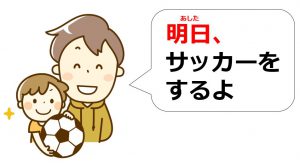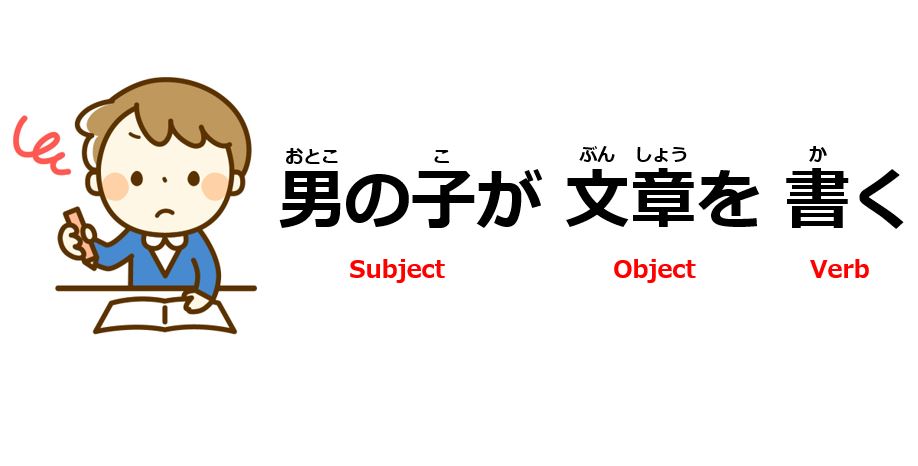By now, you have already spent a while learning Japanese. You may wonder if word order is not important in Japanese. In fact, when you speak Japanese, you don’t have to pay attention to word order as much as other languages. However, there are certain rules that you should follow.
Explanation for How Japanese Word Order Is Determined
In order to explain word order, we will show you examples without omissions. Therefore, they are not natural expressions. In Japanese, properly making omissions is the key to making natural expressions, which we will focus on in other lessons.
Basic Word Order
In grammatical terms, Japanese word order is SOV (Subject + Object + Verb). However, objects can be further divided into groups such as targets (indirect objects) expressed by the particle に, destinations expressed by the particle へ, etc. Thus, we would like to learn word order by using specific terms such as に part, へ part, and を part.
Subject (が Part) + Object (を, に, へ, and と Part) + Verb
| 田中さんが歌を(歌う / 歌います)。 Tanaka-san will sing songs. |
| 田中さんがアメリカに(行く / 行きます)。 Tanaka-san will go to the US. |
| 田中さんが先生と(会う / 会います)。 Tanaka-san will meet [his/her] teacher. |
| 田中さんが海の方へ(向かう / 向かいます)。 Tanaka will head in the direction of the sea. |
This is the basic order (SOV). If there are just three parts of speech, it is relatively easy to compose a sentence. As you have more context, you need to add other parts to this base. Please keep in mind that verbs are always placed at the end in Japanese.
Subject (が Part) + Target (に Part) + Direct Object (を Part) + Verb
| 田中さんが彼女に指輪を(渡す / 渡します)。 Tanaka-san will give his girlfriend a ring. |
| 田中さんが子供に英語を(教える / 教えます)。 Tanaka-san will teach children English. |
This is equivalent to English sentence structure: SVOO. In practice, the に part and the を part sometimes trade places, but you can treat this order as a base. The idea is that animate things are placed first and inanimate things are placed next.
Temporal Noun and Location (に and で Part ) Are Placed at the Beginning
| 明日、田中さんが歌を(歌う / 歌います)。 Tanaka-san will sing songs tomorrow. |
| 夏に田中さんがアメリカに(行く / 行きます)。 Tanaka-san will go to the US in the summer. |
| 公園で田中さんが先生と(会う / 会います)。 Tanaka-san will meet the teacher in the park. |
| 明日、公園で田中さんが先生と(会う / 会います)。 Tanaka-san will meet the teacher in the park tomorrow. |
By location, we mean locations of actions or existence (*You will learn the function about locations of existence in the next section). Don’t be confused about the functions: destinations and directions. Although they indicate locations, we categorize them into objects. If you use both time and locations, time should be prior to locations.
Supplementary Information Should Be between Subject and Object
| 田中さんがマイクで歌を(歌う / 歌います)。 Tanaka-san will sing songs with a microphone. |
| 田中さんが彼女と映画を(見る / 見ます)。 Tanaka-san will see a movie with his girlfriend. |
| 田中さんが今から学校に(行く / 行きます)。 Tanaka-san will go to school from now. |
With the above examples, we have used means (で part), partners (と part), and starting points (から part). In terms of grammar, there are no exact rules, and sentences can be understood even if you place them after objects. However, the order “Subject + Supplementary Information + Object + Verb” is more commonly used.
マイクで歌を歌う: 8,730 hits
歌をマイクで歌う: 4,230 hits
彼女と映画を見る: 46,100 hits
映画を彼女と見る: 5,100 hits
今から学校に行く: 121,000 hits
学校に今から行く: 49,700 hits
Above are the results of Google-searching the phrases by using their perfect matching function. There is a big difference made by whether supplementary information is placed before or after objects.
一生懸命歌を歌う: 2,000 hits
歌を一生懸命歌う: 1,580 hits
ゆっくり英語を話す: 506 hits
英語をゆっくり話す: 677 hits
For reference, adverbs can naturally be used when it is placed both before and after objects.
The Topic Particle は
| 田中さんがマイクで歌を(歌う / 歌います)。 |
| マイクでは田中さんが歌を(歌う / 歌います)。 |
| 田中さんが彼女と映画を(見る / 見ます)。 |
| 映画は田中さんが彼女と(見る / 見ます)。 |
| 田中さんが今から学校に(行く / 行きます)。 |
| 学校には田中さんが今から(行く / 行きます)。 |
Since you have already learned about combined particles, you can figure out the difference in nuance. Here, let’s focus on the word order. The parts that have the topic particle は attached, will move to the beginning.
| 明日、田中さんが歌を(歌う / 歌います)。 |
| 明日は田中さんが歌を(歌う / 歌います)。 |
| 田中さんが先生と(会う / 会います)。 |
| 田中さんは先生と(会う / 会います)。 |
If those parts are already at the beginning, the word order will remain as it is.
[adsense]
Variation of Word Order
You have learned the basic word order so far, but native speakers don’t necessarily always follow that base. In practice, especially in conversation, the order often varies. Let’s look at three patterns.
1. Unimportant Parts Are Placed at the End
| 田中さんが日本語の宿題を(する / します)よ。 |
| 田中さんが宿題を(する / します)よ、日本語の。 |
Both of them have the same meaning: “Tanaka-san will do Japanese homework.” If only the fact that Tanaka-san will do his homework is important, you may initially forget to mention 日本語の. Then, after finishing your speech, you may complement your sentence by adding 日本語の.
| A: 何を買う(の / んですか)? What will [you] buy? B: パン(だよ / です)、明日の昼ごはんの。 [It] is a bread, which is tomorrow’s lunch. |
This is very natural conversation. He/she directly replies to the question, which is most important here, and then adds some context.
2. Parts Which You Emphasize Are Placed at the Beginning
| 田中さんが日本語の宿題を(する / します)よ。 |
| 日本語の宿題を田中さんが(する / します)よ。 |
When you use the second example, you may be surprised because Tanaka-san rarely does Japanese homework, and you therefore want to emphasize 日本語の宿題を.
| 明日は寿司を食べる(んだ / んです)。 |
| 寿司を明日は食べる(んだ / んです)。 |
This is applicable even when the topic particle は is used. The meanings are the same: “As for tomorrow, [I will] eat sushi.” However, the second example strongly expresses your desire to eat sushi.
3. Long Parts Should Be Placed at the Beginning
| 私は田中さんがソニーのカメラで撮る山の写真が好き(だ / です)。 |
| 田中さんがソニーのカメラで撮る山の写真が私は好き(だ / です)。 |
The meaning is “I like the pictures of mountains that Tanaka-san takes using a Sony camera” In English, this kind of sentence is not preferred: “Eating Japanese cuisine with my best friends at my home is fun.” Similarly, in Japanese, long parts are often placed at the beginning.
Summary
- Subject (が part) + object (を, に, へ, and と part) + verb, i.e. SOV, is the basic structure.
- Temporal nouns and locations (に and で parts of sentences) are placed at the beginning.
- Supplementary information should be between subjects and objects.
- The は part of the sentence should be placed at beginning.
- In conversation, word order often varies.
- Verbs are always placed at the end.
Again, Japanese language doesn’t require you to strictly follow the basic word order, especially in conversation. Your Japanese will probably make sense if you keep verbs placed at the end. However, when you make a public speech or write essays or articles, it is important to be able to use proper word order. Please keep the summary in mind.

How Japanese Question Words Work Outside of Wh-questions

Present and Future Tense with Temporal Nouns



